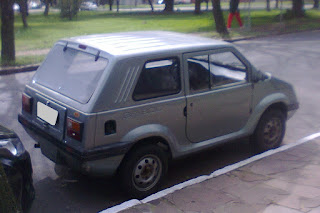With the first production-ready prototypes featured in Brasília during the Independence Day Military Parade in september 7th, 1987, and the deliveries starting in the following year, the Gurgel BR-800 was not so much of a commercial success but had some technical features that rendered it effective as a viable replacement for the Beetle. Despite having a front-mounted engine while retaining the rear-wheel drive, which called for a presumably less-efficient transmission setup due to the presence of a driveshaft, the 50-50 unloaded weight bias meant any compromise to the the cross-country capability would be minimal. Relying on the same 4-speed manual transmission and rear axle found in the 1.4L versions of the Chevette, the Gurgel-designed 0.8L water-cooled OHV flat-twin was meant to reach the then-impressive 25km/l (around 62MPG) fuel consumption. Overall performance was not really something to brag about, but neither were some comparable European-designed cars that were never brought to Brazil by the local branches of foreign automakers such as Fiat. Featurng a space-frame chassis with a fiberglass-reinforced plastic body, its manufacturing was somewhat labor-intensive and time-consuming in a comparison to the pressed-steel unibody layout which was already widespread among major automakers.
Marketing was not so great, with the sales between 1988 and 1990 being tied to stockholding of the company and therefore it became a less attractive option for those buyers who were just looking for a no-frills car and nothing else. The situation became worse for Gurgel in 1990 when Fiat applied for a fiscal incentive for cars up to 1.0L instead of 0.8L and the Fiat Uno Mille could be offered at a more competitive price due to the greater production scale inherent to its design. As a former director of the local branch of Mercedes-Benz once said, Brazilian people consider the size of a car as one of the most relevant matters comparing different models close in price, so the 3.195-metre long and 1.47-metre wide BR-800 was in a clear disadvantage against the Fiat Uno, being phased out in 1991 with a technically-similar model named Supermini replacing it from 1992 to 1994 when Gurgel went out of business. However, nowadays with a new generation of small city-cars flourishing even in Brazil, it's worth to remind the Gurgel BR-800 and the attempt to effectively replace the Volkswagen Beetle.


Lasciate ogni speranza voi ch'entrate. The automobile market is riddled with failures of engineers like Gurgel, Tucker and the like.
ReplyDeleteA plastic made body is a no brain alternative: too expensive to made in big scale and second class rated in the imagination of public.
A car with no known name behind is not very effective if you look for a car with value in the second hand market.
And by no means a "logical" alternative will beat a "fancy" alternative in the eyes of people that uses the car as a step up in the social ladder.
The same technology and concept that made possible Gurgel to make a niche car was utterly ineffective to sell an car for the mass market.
In the discharge of Mr. Gurgel, I would mention that this kind of gross mistakes were made time and again elsewhere: the Rastrojero in Argentina is a handy example.
Gurgel was already well known for the Volkswagen-based vehicles, which were much sought after in the '80s due to the lack of competition (imports were forbidden) and the price compared to the Toyota Bandeirante, the Engesa and the Jeep CJ-5 which were the only 4WD vehicles officially available in Brazil during the '80s (full-size Chevrolet and Ford 4WD trucks were actually converted with kits supplied by Engesa). The plastic body panels would have been more competitive if Gurgel had invested on injection-moulding for a larger production volume and a lower cost in the long run, instead of resorting to hand-moulding. Just look at the Chevrolet Lumina APV and the Corvette which resorted to FRP too, and the European version of the Citroën Méhari which resorted to an injection-moulded bodyshell in contrast to the FRP used in its Argentinian and Uruguayan counterparts. Gurgel failed because he trusted too much the Brazilian politicians after the end of the Military Regime, believing they would be as supporting to local enterprises as the military used to be. And apart from the Fiat Uno Mille, he felt a harder hit when imports were re-opened in the '90s and a Lada Niva came for a lower price tag than the RWD-only Gurgel Carajás.
DeleteSomewhat of a spiritual predecessor to the up!? I wonder when will people start to point out Mr. Gurgel as some sort of a Brazilian disciple to Josef Ganz.
ReplyDelete